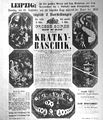Anton Kratky-Baschik
Anton Kratky-Baschik (* 1821 in Prague ; † August 28, 1889 in Vienna ) was a magician and showman as well as an inventor of musical instruments.
Life
Anton Kratky-Baschik began as a musician and performed as a harmonica player in Prague at the age of 16 . In Berlin he met one of the most popular and well-known German magicians of the 19th century, Bellachini , who hired him for his evening program. He developed his own musical instruments, such as the "horn melodion", in which he combined harmonica with horns.
Kratky-Baschik then began to deal with physical experiments. He decided to become a magician himself and began doing magic tricks in 1850 . He traveled through Germany with his brother's eldest son as an assistant. From 1852 he had his own program, which also included magical appearances. For two years from 1854 he performed with the American circus pioneer Phineas Taylor Barnum in England and America, where he originally specialized in ghost performances.
Finally he settled in Vienna in 1862/1863 and opened his first permanent magic theater in 1864 on the Feuerwerkallee, the later exhibition street in the Wiener Wurstelprater , which only lasted a year because Kratky-Baschik made a tour of Bohemia, Hungary and the wider Danube Monarchy as well as undertaken by Serbia. In 1868 he returned to Vienna and built his second magic theater ("Theater for Magic") for the Vienna World Exhibition in 1873 in the Vienna Prater, where he was one of the first to use Geissler's tubes . It had almost 1,000 seats and was then one of the largest magic theaters in the world. In 1874 Kratky-Baschik bought a former monkey theater that went bankrupt after the World's Fair and where he ran his business. One of his employees, Georg Julius Proks, who wooed spectators in front of the bar, also became a Prater legend. He was a popular figure as "the devil of the Kratky-Baschik", who became known with a small, hunched physique and with red horns and a disheveled figure.
In 1882 the decline of the magic theater had already begun. The building began to have structural defects that were reluctantly corrected, the owner was not averse to alcohol. His estate in 1889 comprised around 70,000 guilders.
legacy
According to the Austria Forum , Kratky-Baschik's second theater, which he built in the Vienna Prater in 1873, was continued by his nephew Mathias Kratky and from 1898 to 1911 by the magician Ottokar Fischer (1873-1940, President of the Magical Club Vienna).
In 1963, in memory of Anton Kratky-Baschik, the Kratky-Baschik-Weg was named in the second Viennese district Leopoldstadt in the Wurstelprater . He is buried in the Vienna Central Cemetery, the epitaph calls him a “master of his art”.
He is referred to in Heimito von Doderer's 1956 story Another Kratki-Baschik . Doderer mentions that the first part of the family name coming from the Czech was written as Kratki in an attempt to “Arabicize or Turkicize” the name and the second part of the name Baschik is a Turkish-sounding word that does not appear in the same form in Turkish. The name is displayed as an artist name, regardless of the spelling. But it also appears on the tombstone. This is only proof of general recognition, not proof of an official name change.
Evidence of Kratky-Baschik can be seen in the Circus and Clown Museum in Vienna.
literature
- Pemmer: Kratky-Baschik Anton. In: Austrian Biographical Lexicon 1815–1950 (ÖBL). Volume 4, Verlag der Österreichischen Akademie der Wissenschaften, Vienna 1969, p. 215.
Web links
- Anton Kratky-Baschik
- Entry on Anton Kratky-Baschik in the Austria Forum (in the AEIOU Austria Lexicon )
- Anton Kratky-Baschik , Central Cemetery Person Index
References and comments
- ↑ There are contradicting information regarding his date and place of birth. The Austria Forum states January 11, 1810 in Kozlány, the Artist's Lexicon on November 6, 1820 in Prague, and the Austrian Biographical Lexicon in Prague in 1821. The inscription on the tablet of the crypt "Kratky-Baschik" in the Vienna Central Cemetery says 1822. And the grave directory of the administration of the Vienna Central Cemetery from 1889 gives his total age at 69 years.
- ^ The Hall of Fame of the Society of American Magicians gives Anton Kratky-Baschik January 11, 1821.
- ↑ a b c d e f g h Clemens Marschall: Kratky-Baschik and his devil. In: Wiener Zeitung . August 22, 2017, p. 12.
- ↑ Entry on Anton Kratky-Baschik in the Austria Forum (in the AEIOU Austria Lexicon )
- ↑ the possibility of an Arabic word is not mentioned, Arabic "Baschik" is a word for the sparrowhawk : Hammer-Purgstall, Falknerklee consisting of three unprinted works about the falconry, Pesth 1840, page 8 in the Google book search.
- ↑ Heimito von Doderer: Another Kratki-Baschik . In: The torment of the leather bags and other stories. (Excerpt from: Doderer: Die Erzählungen , Biederstein Verlag Munich 1972. ISBN 3-7642-0149-5 ). German paperback publisher dtv. July 1984. ISBN 3-423-10287-X , pp. 24–37, here: p. 27.
| personal data | |
|---|---|
| SURNAME | Kratky-Baschik, Anton |
| BRIEF DESCRIPTION | Magician and showman |
| DATE OF BIRTH | January 11, 1810 or November 6, 1820 or 1821 or 1822 |
| PLACE OF BIRTH | Prague , Kingdom of Bohemia , Habsburg Monarchy |
| DATE OF DEATH | August 28, 1889 |
| Place of death | Vienna , Austria-Hungary |



